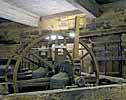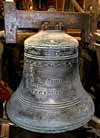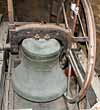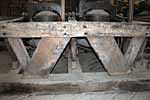For this church:    |
|
1. |
Cast 1706/7 by William |
Note D flat |
2. |
Unknown |
Note C |
3. |
Unknown |
Note B flat |
4. |
Unknown |
Note A flat |
5. |
Unknown |
Note G flat |
6. |
Unknown |
Note F |
7. |
Unknown |
Note E flat |
8. |
Cast 1706/7 by William Noone |
Note D flat Weight about 28 cwt. |
The ring before 1706 must therefore have been much heavier with a tenor of about 40 cwt and the sale of this broken tenor financed the 1706/7 restoration. It can be surmised that this earlier ring would be:
1. |
As 2 above |
Note B |
2. |
As 3 above |
Note A sharp/ B flat |
3. |
As 4 above |
Note G sharp/ A flat |
4. |
As 5 above |
Note F sharp/ G fiat |
5. |
As 6 above |
Note E |
6. |
As 7 above |
Note D sharp/ E fiat |
7. |
Predecessor to 8 above |
Note C sharp/ D flat Weight about 28 cwt. |
8. |
Unknown |
Note B Weight about 40 cwt. |
To modify the ring Noone would also have needed to alter the notes of bells 1 and 5 by chipping the lips to get the notes up about a semitone, a procedure he had used at Lincoln Cathedral a couple of years before.
Sadly the ring of 1706 would only last for a brief time. On the evening of 5 November 1711, when a very violent thunderstorm passed over Southwell, lightning struck the south west tower and a fire broke out. This burnt the tower, the roofs of the nave and transepts, and melted the bells. The petition to Queen Anne for help to repair the damage stated that eight bells were destroyed, presumably the ones that had been rehung by William Noone.
Money for the repairs must have been raised quite rapidly, for on 1 May 1712, Thomas Clay of Leicester signed an agreement with the chapter, 'to recast, renew, and make good, and to put into as good condition as before the late dreadful fire all the mettle of the old bells that was found remaining amongst the ruins, the bells to be well tuned, well toned and pleasant sounded.' The cost was recorded as £371 14s 11d.
We have to assume that it was at this time that the massive timber frame in which some of the present bells hang was provided. It seems, however, that Thomas Clay's bells proved to be unsatisfactory because on 25 January 1719, many of the inhabitants of Southwell signed an agreement to contribute sums of money towards recasting the bells.
The new bells were made by Abraham Rudhall of Gloucester (who had recently completely recast the bells at Newark) and his agreement for recasting them was dated April 1721. He undertook after the eight bells were delivered to him at Budely (now Bewdley) in Worcestershire, to melt them down and make a new peal 'that shall be in the judgement of any three or more understanding and judicious persons in musick, as good and tuneable and have as sweet and harmonious notes or tones as the bells at Newark, which were lately cast by the said Abraham Rudhall, the whole to cost £100'.
In due course the old bells went to Bewdley and thence down the Severn to Gloucester, were recast and returned to Bewdley and eventually returned to be put up in the minster.
On 25 August 1721 Rudhall wrote giving weights and notes of the new bells as follows:
|
|
cwt |
qur |
£ |
The Treble |
|
07 |
02 |
25 |
The second |
|
07 |
02 |
09 |
Third |
|
08 |
00 |
10 |
Fourth |
|
10 |
01 |
11 |
The fifth |
|
12 |
03 |
19 |
Sixth |
|
15 |
00 |
06 |
The seventh |
|
18 |
03 |
25 |
The eighth |
|
27 |
03 |
27 |
|
Ton |
|
|
|
in all |
5 |
08 |
02 |
20 |
Rudhall recommended that the new bells should be hung by one Francis Wrigley of Manchester 'he being as I believe ye skillfullest person in England in ye business.'
Wrigley did hang the bells, and the chapter paid 10/- for sending a messenger to Manchester to bring him. The total cost of the work including the recasting amounted to £170 17s 6d.
A new frame was constructed (probably in 1722) to take the new bells. All church bellframes were classified in 1945 by George Elphick, using the letters 'A' to 'Z' and then Christopher Pickford developed this classification further with sub-groups in 1993. The wooden frame built in 1722 is, with some minor modifications, in use today. It is an Elphick 'V' type (a jack-braced frame), designated Pickford Group 6B. It has unusually wide braces and jack-braces from the mid point of the main brace to the head. The only other known frame of this exact type (but built on a much smaller scale) is to be found at Ollerton St Giles and dates from 1780.
In 1815 Mr. Ingleman, Clerk of Works, reported upon the state of the collegiate church at Southwell and estimated the expense of repairing the same. He mentioned that the fourth and fifth bells wanted recasting and estimated the cost as £80 5s 0d. From their inscriptions it would appear that they were recast by T. Mears of London in 1819. Thirty years later, the second bell was also recast, this time by C. & G. Mears of London in 1849. Both T Mears and C & G Mears were trading names of the long-established Whitechapel Bell Foundry.
Apart from these recastings and the later rehanging on ball bearings these same bells, hung anticlockwise, remained in service until 1960.
During the period 1848 to 1888, much-needed repair and restoration of the minster took place under the guiding hand of the distinguished architect Ewan Christian. A good deal of the work was needed to deal with the hasty and supposedly temporary action taken in the aftermath of the 1711 fire. Christian was determined to ensure that the central tower was improved and enhanced, both structurally and aesthetically.
It was found upon detailed examination that damage to the tower had been repaired with plasterwork and then whitewashed over. There was loose stonework 'ready to fall' it was reported to Christian, and the ringing of any of the bells 'save one small one' was prohibited until urgent remedial work could be carried out.
The original internal structure of the tower above the crossing was in the form of a lantern, intended to be seen from below. The post-1711 structural work had obscured this completely, with an inappropriately low ringing floor. Christian’s solution was to construct a ringing gallery, 5' 6" in width, below the lantern windows. This was completed in 1854, partly utilising recovered timbers, at a net cost of £19.13.6d.
When a new tower clock was installed in 1898 to celebrate Queen Victoria’s Diamond Jubilee, two additional bells cast by John Taylor of Loughborough were added to the frame to mark the same event. They were given by Mr. Starkey of Norwood Park and were hung dead (that is to say, not for ringing). They were added simply to enable the chimes of the chime drum to be altered to include the National Anthem. After that it played three tunes:
Innocents, or Conquering Kings their Titles Take
Southwell, or Jerusalem My Happy Home;
The National Anthem.
The bells did not leave the tower again until 1960 when they and the chiming bells were removed to Messrs. J. Taylor & Co. at Loughborough. They were subsequently recast and augmented to become, with the inclusion of the two 1898 bells, the first peal of twelve bells in the Diocese. (There are actually 13 bells, a flat 6th being included to make a light ring of ten). The original inscriptions placed on the bells by Abraham Rudhall were replaced on the new bells with the added inscription, 'By the generosity of Sir Stuart Goodwin our bells were reconstructed and augmented in 1961.'
The bells were re-hung in the old 1772 timber frame which had to be extended by John Taylors and modified to include cast-iron side-frames. When the installation was complete, this became the only anti-clockwise peal of twelve bells in the world. Not only is this unique but it also makes them so much more difficult to ring well.
At the same time in 1961, the ringing gallery was removed. It had been used to ring eight bells, with two bell ropes and two ringers per side. The ringers stood facing inwards, with their backs to the lantern openings and the stout wooden balustrade in front of them. They also faced some unsightly netting, presumably fitted for added security.
The removal of the ringing gallery was necessitated by the upgrade to twelve bells, since such a number could not be rung using the old arrangement. Consequently a new floor was inserted across the tower. The contractor’s design involved spans of timber which were inappropriately lengthy and as a consequence the new floor began to sag soon after installation. Subsequently this defect was corrected by inserting steel beams above the unsafe floor and building a new floor for the ringing chamber. Thus the timber seen from below whilst standing in the crossing is not load-bearing and is in fact a false ceiling.
The present bells
 Bells and bellframe Bells and bellframe |
 Bells and bellframe Bells and bellframe |
 Bell 5 Bell 5 |
 Bell 12 Bell 12 |
Details of the present bells are as follows:
| Inscription | Size | Weight | Founder | |
| 1 | JOHN TAYLOR & CO * FOUNDERS * |
25.75” |
4.2.16 |
John Taylor Loughborough |
| 2 | JOHN TAYLOR & CO * FOUNDERS * |
26.5” |
4.3.0 |
John Taylor Loughborough |
| 3 | ABR: RUDHALL OF GLOCESTER CAST VS ALL [ ] 1721 [ ] |
26.75" |
5.0.17 |
John Taylor Loughborough |
| 4 | RECAST BY JOHN TAYLOR & CO * FOUNDERS * LOUGHBOROUGH * 1961 * |
28.75" |
5.1.17 |
John Taylor Loughborough |
| 5 | + Domine . salvam fac Reginam + |
29.75" |
6.0.27 |
John Taylor |
6 |
PROSPERITY TO THIS TOWN [125] 1721 |
31.75" |
6.1.26 |
John Taylor Loughborough |
| Flat 6 | J.W JOHN TAYLOR & CO * FOUNDERS * |
34.25” |
6.3.5 |
John Taylor Loughborough |
| 7 | + Domine. Fiat pax in virtute Tua + [ ] |
34” |
8.0.1 |
John Taylor |
| 8 | RECAST BY JOHN TAYLOR & CO * FOUNDERS * LOUGHBOROUGH * 1961 * |
35.5” |
8.0.23 |
John Taylor Loughborough |
| 9 | RECAST BY JOHN TAYLOR & CO * FOUNDERS * LOUGHBOROUGH * 1961 * |
39” |
10.0.27 |
John Taylor Loughborough |
| 10 | PROSPERITY TO THIS CHAPTER [125] 1721 [ ] RECAST BY JOHN TAYLOR & CO |
41.5” |
12.2.15 |
John Taylor Loughborough |
| 11 | PROSPERITY TO THE CHVRCH OF ENGLAND [125] 1721 [ ] |
46” |
17.2.15 |
John Taylor Loughborough |
| 12 | TO THE CHVRCH THE LIVING CALL AND TO THE GRAVE DOE SVMMON ALL 1721 |
52.25” |
25.1.3 |
John Taylor Loughborough |
Bellframe
 The bellframe The bellframe |
 Bellframe truss Bellframe truss |
The bellframe is substantially a wooden frame of 1722, Elphick type 'Z', Pickford Group 6.A, with unusually large main braces and short jack braces. In places it has been augmented by corner posts.
The later additions are composite wood and metal Pickford Group 7.A.b wooden heads and cills with individual cast iron braces (pierced) bolted to cill and head. Also Pickford Group 8.2.A all metal trusses compounded with the main frame.






